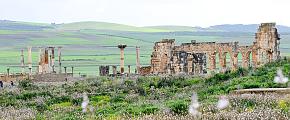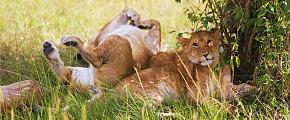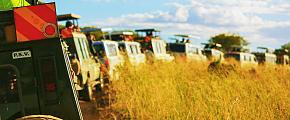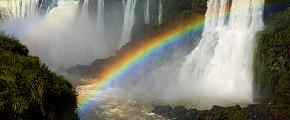How to Plan Your First Safari (Ultimate Guide for Beginners)
Before starting your first exciting wildlife safari, there is always much you need to know about. The popular destinations, the best time to go on safari, where to stay during the journey, how many days to spend on safari, what to wear and what to pack for a safari, rules and tips, etc. This article will share all this information so that you can fully feel the captivating wild appeal of safari.

What Kind of Safari is Suitable for A Newcomer?
Safari is suitable for almost any wildlife-loving traveler, it makes no special demands on your physical strength or wilderness knowledge.
Safari doesn't require much physical strength as you will be taking transportation or walking slowly. On Savannah safari, you will travel in a 4WD vehicle most of the time, observing the wildlife from the vehicle; on rainforest safari, you will travel by boat or slowly walk; on sea safari and polar island safari, you'll take a cruise ship, and if you suffer from seasickness, it is important to take precautionary measures, as prescribed by your doctor, so that you can enjoy the whole trip.
As a novice, you don't have to worry about having little knowledge of the wilderness either, because the whole time you will be following professional safari guides who will do their best to take you to find more wildlife you are looking forward to seeing, while keeping you safe in the wilderness, and what you need to do is to listen to their advice.
Popular Safari Destinations
When you're picking safari destinations, you'll be excited to find so many places where countless wildlife live waiting to be explored, from Savannah to rainforest, from the sea to polar island, and here's a look at some of the most popular safari destinations.
1. Savannah Safari - Kenya and Tanzania
African Savannah is home to lions, leopards, elephants, rhinos, giraffes, antelopes, and countless other species of wildlife. Kenya's Masai Mara National Reserve and Tanzania's Serengeti National Park are the best places to see the most famous Great Migration of millions of animals, dominated by wildebeest, zebra, and antelope. Tanzania's Ngorongoro Crater is home to the Big Five, namely the lion, elephant, leopard, rhinoceros and buffalo, and has one of the highest densities of lions. Kenya's Ol Pejeta Conservancy has more than 100 black rhinos, a critically endangered species.
 Lion in Tanzania's Serengeti National Park
Lion in Tanzania's Serengeti National Park
2. Rainforest Safari - Thailand, Malaysia and Peru
Rainforest is the most species-rich place, with countless animals you won't see anywhere else. The wild and pristine rainforests in Thailand, Malaysia and Peru have millions of species of insects, thousands of species of fish and birds, and are home to adorable pink dolphins and otters, as well as jaguars, crocodiles, piranhas and bull sharks that are more interesting to adventurers. Borneo rainforest in Malaysia is home to the world's smallest elephant, the Borneo Pygmy Elephant, the world's smallest bear, the Borneo Sun Bear, the flying squirrel, the proboscis monkey, the clouded leopard, and the endangered orangutan.
 Pink Dolphin in Amazon Rainforest, Peru
Pink Dolphin in Amazon Rainforest, Peru
3. Sea Safari - Sri Lanka and Kenya
The sea is spread all over the planet, and you have diverse choices about where to go for a sea safari. Sri Lanka's Mirissa is one of the best destinations to see the largest living creature on earth, the blue whale. Mirissa has very well-developed whale-watching eco cruises, and the experienced guides will take you to see this mind-blowing sea creature up close. In addition, you can see killer whales, sperm whales, fin whales, dolphins, whale sharks, sea turtles and much more. Kenya's Watamu National Marine Park witnesses the Great Humpback Whale Migration every year, which you can see by whale watching boats, and it is also home to dolphins, killer whales, and endangered green sea turtles.
 Whale Watching in Mirissa, Sri Lanka
Whale Watching in Mirissa, Sri Lanka
4. Polar Island Safari - Svalbard
Svalbard, located in the northernmost part of Europe, is known as the kingdom of the polar bears, where there are only about 2,600 citizens, but about 3,500 polar bears. In addition to polar bears, there are also walruses, seals, narwhals, belugas and other animals for you to explore.
Best Time to Go on Safari
Migration is an important habit of wildlife as they usually change their habitat depending on the climate. So it is always important to choose a better time to capture the magnificent scenery of this limited event.
- In the rainforest, the environment does not change much throughout the year. Although the two seasons vary from region to region, you can still see a significant number of animals throughout the year. In the dry season, with lower water levels, it is less difficult to do a walking safari in the rainforest. For canopy birding, the rainy season with rising water levels is always a good time to go. Here is the dry & rainy season in different rainforests:
Thailand: November to May & June to December
Borneo, Malaysia: March to October & November to February
Amazon Rainforest: June to November & December to May - Many species of marine life can be seen at sea throughout the year, but some of them are more likely to be seen at certain times. In Kenya, the humpback whale migration peaks between August and September each year, and killer whales are most likely to be seen in February. The period you can enjoy whale watching in Mirissa, Sri Lanka would be a little longer with more options for May to October.
- Going on a Safari in the polar islands is best done in the summer months as the temperatures are less difficult to acclimatize to and the animals are easier to spot once the snow and ice begin to melt. In Svalbard, polar bears, walruses, and even blue whales are more likely to be seen during summer, especially in June.
- The Great Migration, the most famous of the African Savannah, can be seen in Tanzania's Serengeti National Park from July to August and in Kenya's Masai Mara National Reserve from August to October.
 Bird Watching in Rainforest of Borneo, Malaysia
Bird Watching in Rainforest of Borneo, Malaysia
Safari Accommodations
Safari accommodation is varied, from tented camps and lodges to hotels and cruise ships, you can choose according to your accommodation needs.
- Mobile tented camps: They are usually found in the African Savannah safari, mainly for watching the great African animal migration. These tents are makeshift and have simple facilities, but they will fulfill your basic needs.
- Game lodges: It is easy to find all kinds of game lodges in and around safari-capable national parks and wildlife reserves, from simple wooden houses to luxury hotels. The advantage of staying at game lodges is that you have very easy access to safari areas and are surrounded by nature.
- Hotels: If you have never stayed in tented camps or lodges and are worried that you won't be able to adapt, you can stay in a hotel in the city so that you are surrounded by the cityscape that you are familiar with.
- Cruise ships: They are common in rainforest safari and polar island safari, especially in polar island safari when you need to stay on a cruise ship most of the time. These cruise ships have all the facilities and services that a hotel can offer.
How Many Days to Spend on Safari
It is recommended to stay 3-4 days because it takes patience and luck to find more of the wildlife you expect to see in the vast nature. You will follow professional safari guides who will slowly but surely search for the animals until they are spotted.
If possible, you can stay for a few more days to discover more wildlife, especially in the rainforest area, where species are so abundant that you will constantly be surprised. Usually, 5 to 7 days for each so that you can venture deeper into the rainforest and get a fuller sense of it.
To go on a polar island safari, you need one to two weeks, because there are glaciers there and cruises will be slower. For example, the Svalbard safari usually takes about 10 days.
What to Wear on Safari
What to wear on safari is not only about the weather but also about safety. In African Savannah, you need to wear khaki, brown, or olive green clothes that harmonize with your surroundings to help conceal you, and it is always better to wear long-sleeved clothes, long pants and boots to prevent mosquito bites and branch cuts.
In the rainforest, you need to wear a raincoat and rain boots as it is humid and often has briefly rainfall. On sea safari and Savannah safari, sun protection is especially needed, and you can wear a hat with a wide brim, sunglasses and a silk scarf.
For sea safari, wear quick-drying clothes and water-proof shoes, and travel with an extra windproof jacket. If you want to dive to get close to the marine life, please be prepared with a full set of diving equipment.
On polar islands, no matter what season it is, please wear cold-proof clothing. In the summer months, the temperature in polar regions generally ranges between 0 and 7 degrees Celsius, so cold-proof and water-proof clothing, snow boots, gloves and hats are still essential to avoid frostbite.
 Wear Hat and Long Sleeves for Sun Protection
Wear Hat and Long Sleeves for Sun Protection
What to Pack for Safari
- You always keep a certain distance from the animals, so binoculars are indispensable; and your cameras are best paired with telephoto lenses to take clearer pictures of the animals.
- Bug spray and sunscreen can not be missed, and you'll need moisturizer and lip balm whether you're in the dry African Savannah or the cold polar regions.
- Bring common medicines such as cold medicine, anti-inflammatory medicine, allergy medicine, stomach medicine and so on.
- Have cash on hand because some areas do not allow online payments or credit cards; and bring some change for tips.
Safari Rules
- Please listen to your professional guides and follow them closely.
- Don't disturb and feed wildlife; don't get too close to wildlife or touch them.
- Always remember to turn off your camera's flash, which will hurt the animals' eyes and frighten them.
- Do not use perfume. Many wild animals rely on their sense of smell to judge their surroundings, and perfumes will cloud them.
- Don't eat while watching the wildlife, they may grab your food.
- Get the vaccinations before going on safari so that you can enjoy the trip better.
- Don't use fire or smoke in the wilderness and don't leave any trash behind.
Go out into nature, observe the cute or thrilling moments of all kinds of wild animals, and get to know the world from another perspective. Let Odynovo create travel plans and handle possible hassles for you, so you can enjoy your trip to the fullest.
Quick Question
Related Posts You May Like
What Our Clients Say
Explore the latest verified reviews of Odynovo's travel services on Tripadvisor, Google, Trustpilot, Product Review and more trusted platforms.

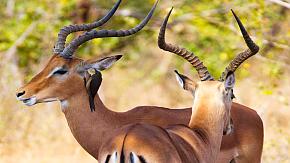

 Bird Watching in Rainforest of Borneo, Malaysia
Bird Watching in Rainforest of Borneo, Malaysia
